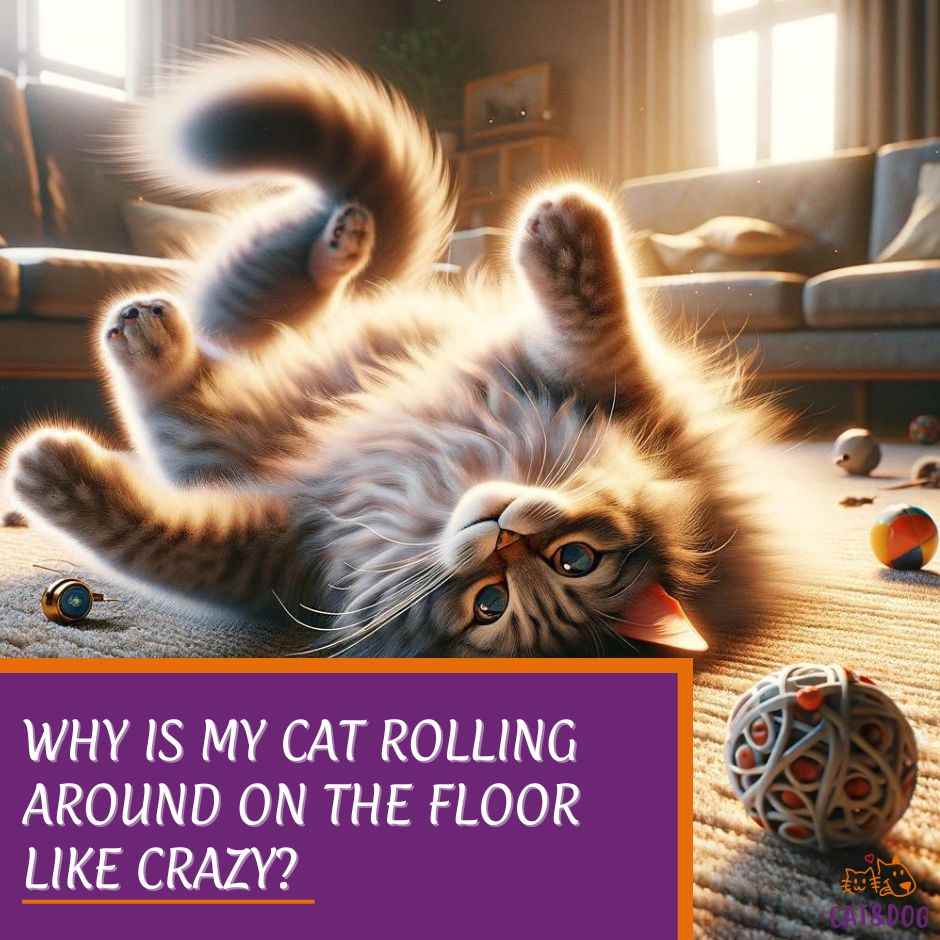Observing your cat as it rolls around on the floor with what seems like wild abandon, you might wonder if this is just another quirk of your feline friend or if there’s more to the story.
So, “Why is my cat rolling around on the floor like crazy?”
It’s not uncommon to see your cat throwing itself onto the ground, wriggling back and forth with its paws flailing in the air, and you standing there, perplexed.
This behavior, while entertaining, can actually be a form of communication, a playtime session, or even a way to relieve an itch.
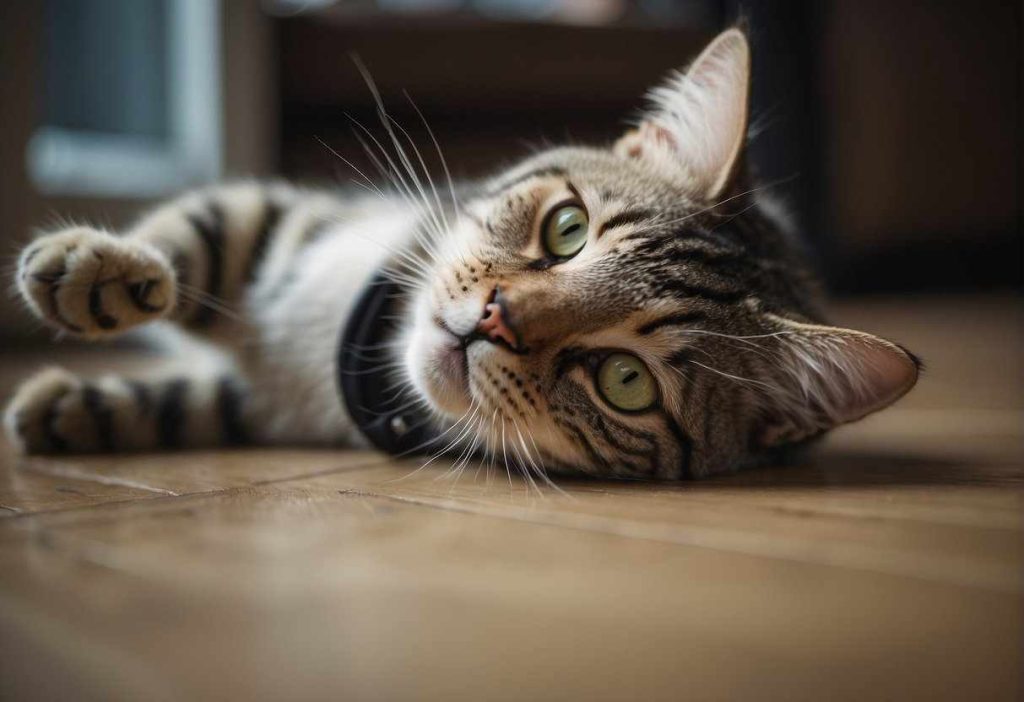
Your cat’s rolling might signify several things, including a relaxed state, willingness to play, or the marking of territory with the scent glands located in their cheeks.
However, it’s important to recognize when the behavior could be a cry for help or an indication of an underlying health issue.
Keeping an eye on the context and frequency of this behavior can offer you personalized insights into your cat’s well-being and deepen your bond with your fluffy companion.
Key Takeaways
- Rolling can indicate relaxation, playfulness, or scent marking.
- Frequent, context-driven observations are key to understanding rolling behavior.
- Noticing behavioral changes is vital for identifying health concerns.
Why is My Cat Rolling Around on the Floor Like Crazy? Understanding Cat’s Behavior
The Basics of Feline Rolling
Playful Rolling: A common sight is your cat wriggling back and forth during playtime. It’s their way of practicing hunting techniques, where belly-up displays mimic capturing prey.
Attention-Seeking Rolling: When your cat rolls over, they might be seeking your affection or inviting you to engage with them—think of it as a cute, furry little siren call for belly rubs (but proceed with caution, as the feline belly is a well-known trap).
Common Reasons Behind the Rolls
Table: Cat Rolling Reasons
| Type | Reason | Explanation |
| Emotional | Comfort | Cats may roll to show contentment and relaxation. |
| Behavioral | Scent Marking | Rolling helps cats leave their scent, marking their territory. |
| Social | Communication | A roll can indicate submission or trust to humans and other pets. |
| Physical | Itch Relief | Cats roll to scratch a persistent itch they can’t reach otherwise. |
By observing your cat’s context and body language, you can decipher whether they’re feeling playful, lovey-dovey, or just having a case of the itches.
It’s a complex little world they live in, and tumbling across the carpet is their way of sending signals both to their environment and to you. Isn’t feline language fascinating?
Keep an eye out for these behaviors, and you’ll become fluent in no time!
Recognizing Signs of Distress and Health Concerns
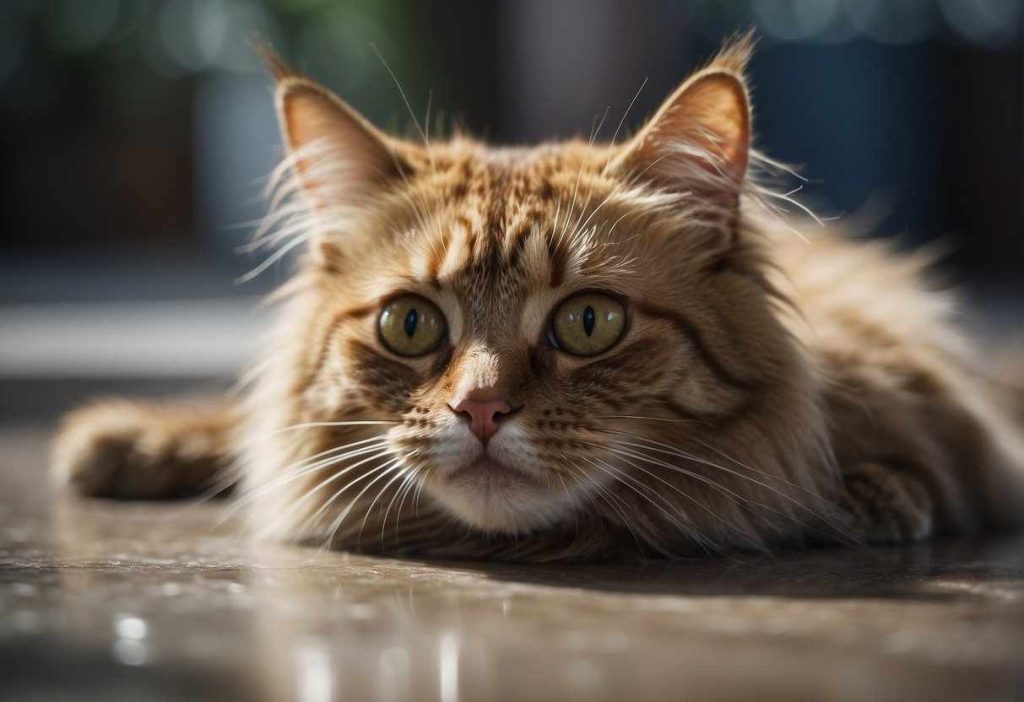
Abnormal Behaviors to Watch For:
- Excessive rolling: If it’s more than usual, it might be a sign.
- Vocalizations: Are they meowing or yowling while rolling? (1)
- Lethargy: Do they seem more tired or less playful otherwise? (2)
Physical Symptoms That Might Accompany Rolling:
- Hair loss: A little extra fur on the couch is normal, but bald spots? Not so much. (3)
- Scratching or biting skin: It could point to parasites or allergies. (4)
- Unusual odor: A sign of infection or something else that’s off. (5)
If you spot any of these, what’s the game plan?
Simple: let’s not play Dr. Google.
If you suspect your cat’s rolling is out of the ordinary, it’s time to phone the true expert – your vet. They’re like the detectives of the animal world, and they’ll help you get to the bottom of it.
Now, when it comes to your cat’s antics, you’re the expert. You know their usual routine better than anyone else.
If your gut tells you something’s off, trust it.
Worried they might be in distress or dealing with a health issue? Here’s what you need to do:
- Calm Observation: Take note of all the unusual behaviors.
- Vet Time: Don’t hesitate to make that appointment.
- Follow-Up: Keep an eye on any changes after your vet visit. (6)
Remember, it’s better to be safe than sorry!
Your cat counts on you to catch things early, and tackling potential problems quickly is always the best move. Your vigilance and prompt action can make all the difference for your fuzzy buddy’s well-being.
Keep that playful spirit alive by ensuring their health is tip-top!
Behavioral Triggers and Personalized Insights

Why the Acrobatics?
Rolling around can signify a few things:
- Happiness: Just like you might flop down in bed after a long day, cats roll on the floor to express contentment. (7)
- Scent Marking: The floor is now their domain! With scent glands aplenty, cats rub to claim territory.
- Attention-Seeking: Your cat might as well hold up a sign saying, “Hey, you! Let’s interact!”
- In Heat: If your cat isn’t spayed, this could be a flirty display for potential mates.
What’s the Scenario?
For indoor cats:
- Playtime: Offer a variety of toys. Some cats prefer a laser pointer dash; others go nuts for a simple string.
Adult cats:
- Routine Roll: Adult cats might roll as part of their daily zen routine. Respect their space during these moments.
Kittens:
- Learning Curve: All that rolling? It’s Kitty 101. Through play, they’re figuring out the world—and their limbs!
Outdoor cats:
- Watch the Grass: Is it catnip or just a delightfully textured surface? Either way, they’re in ecstasy.
So, next time your whiskered companion starts their peculiar gymnastics, take a moment to consider what they’re telling you.
Is the room filled with their favorite people, or did you just vacuum away their hard-earned scents?
And remember, whether they’re claiming their territory with a twist or simply indulging in a good back rub, each roll is a story in the tale of their day.
Interactive and Proactive Solutions
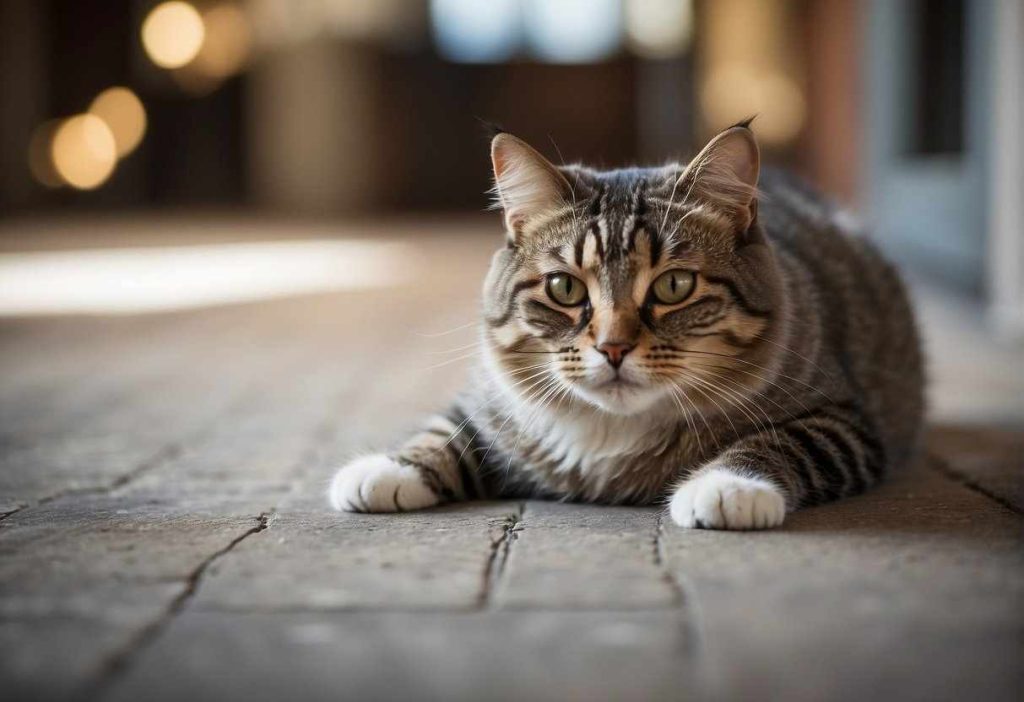
Make Playtime Purr-fect:
- Chase the Laser: Cats love a good chase. Grab a laser pointer and watch your cat zoom after that elusive red dot.
- Catnip Surprises: Sprinkle a bit of catnip on their favorite toys. It’s like a cat party and you’re the honored guest!
- The Classic String: Dangle a piece of string or a feather wand and engage in an epic battle of cat vs. cunning prey.
Understanding Their Needs: Engaging with your cat goes beyond just fun and games; it plays a vital part in their well-being. Here’s how you can address their needs:
- Mental Stimulation:
- Puzzle Feeders: Not just for food; they challenge your cat’s brain!
- Hide-and-Seek: Their hunting instinct will kick in while they search for you or treats around the house.
- Physical Exercise:
- Obstacle Course: Create a mini-adventure playground.
- Interactive Toys: Toys that move unpredictably get those paws batting and the body moving.
Engagement isn’t just about keeping your cat from redecorating your floor with their furry antics; it’s about creating a bond and ensuring they lead a healthy and happy life.
Have you had your daily dose of chuckles watching your cat’s acrobatics yet? If not, it’s time to get interactive!
Remember, happy cat, happy life!
Expert Insights and Real-life Examples
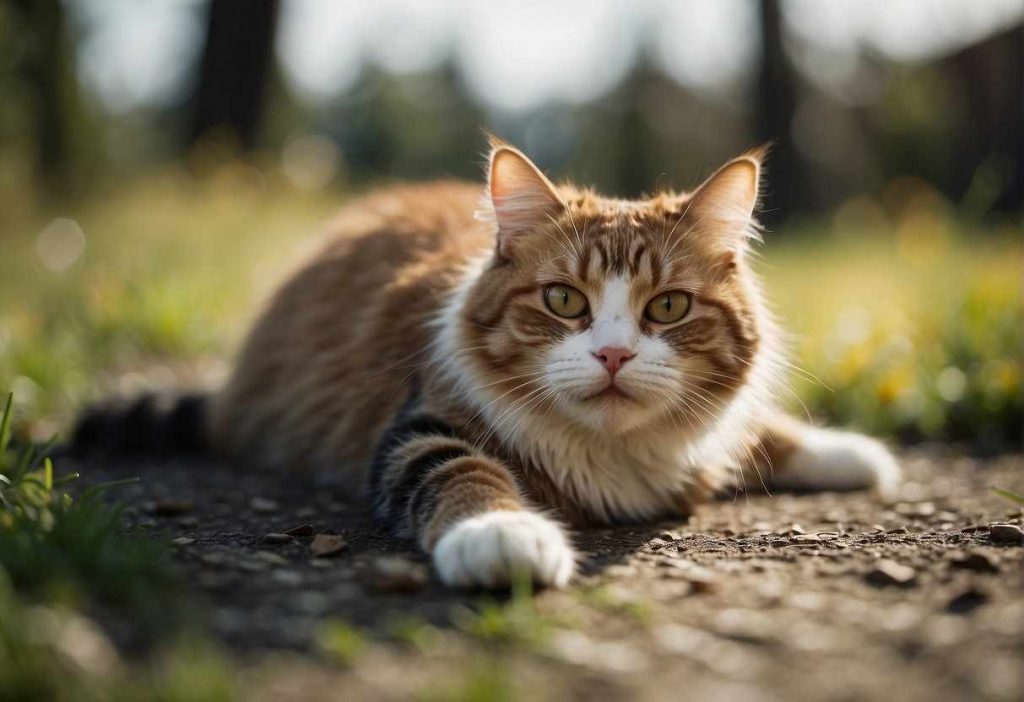
Veterinarians and animal behaviorists suggest cats roll around on the floor for many reasons, ranging from feeling playful to trying to get your attention.
One veterinarian, Dr. Whiskers, notes that cats often roll around as a form of self-expression. They might be marking their territory with the scent glands located on their cheeks and paws.
Another reason, according to behaviorist Kitty Purrington, is they could be in heat or expressing their comfort and trust in their environment.
Quick Tips:
- Keep an eye on patterns: If your cat always rolls around after playing, it might just be a sign of contentment.
- Offer a scratching post: Sometimes they need a good surface to stretch and scratch.
Examples to Look Out For:
- Territorial Scenting: Watch how your cat might cheek-rub objects after rolling around.
- Attention Seeking: Does your cat stare at you while rolling? They might want some playtime!
Here’s a real-life story for you:
Mr. Fluff, a Maine Coon, would roll over every time his owner came home. After a quick check-up, it turned out Mr. Fluff was signaling his love and happiness.
Remember, if the rolling seems excessive or is accompanied by meowing or unusual behavior, it’s best to consult your vet.
After all, you wouldn’t want to miss a cue that your furball is actually in need of help, right?
Keeping a closer eye on these nuances can strengthen your bond with your cat, ensuring they’re both healthy and happy.
Advanced Understanding and Bonding Techniques
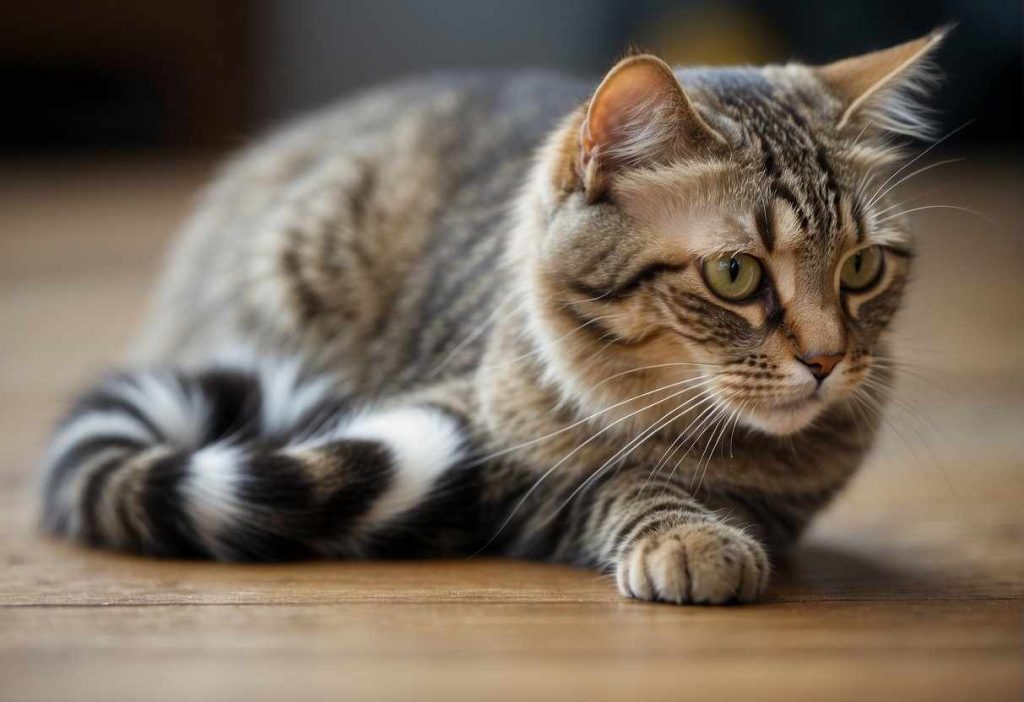
Behavior Decoding
- Observation: Take note of the circumstances when your cat rolls — is it during playtime, after a nap, or when you come home?
- Mood Gauging: Body language can reveal your cat’s mood.
- A relaxed posture with a softly swishing tail suggests contentment, while rapid tail movements might indicate overstimulation.
Interactive Playtime
- Quality Toys: Use toys that mimic prey movements, promoting natural hunting behaviors.
- Active Participation: Engage with your cat in play, ensuring both mental and physical enrichment.
Catered Care Routine
- Environmental Enrichment: Create a cat-friendly environment with climbing shelves, scratching posts, and hideaways.
- Consistency: Establish a routine that suits your cat’s feeding, grooming, and play habits.
Enhanced Communication
- Verbal Cues: Use a soothing tone when speaking to encourage calm rolling as a sign of trust.
- Physical Interaction: Approach for petting or playtime based on your cat’s demonstrated preferences.
In short, to bond with your cat, be patient, observant, and responsive.
Engaging in advanced understanding and bonding techniques tailored to your cat’s unique personality will foster a rich and rewarding relationship.
Who knows, in time, you might just become the best of pals, rolling around on the floor together!
Quick Recap

Common Reasons for Rollicking:
- Joyful Play: Your cat could be releasing pent-up energy or showing its playful side—a sign of a content feline!
- Attention-Seeking: Sometimes, they’re just looking for your love and interaction. Aren’t we all?
- Scent Marking: They’ve got scent glands all over and might be claiming the floor as their territory… or their dance floor.
Behavior Observations:
- Mood Check: Are they purring or meowing loudly? It’s like a mood ring but with fur.
- Frequency: Is this a one-time show or are there encores every few hours? Keep an eye on patterns.
- Other Symptoms: Any other odd behaviors? Might be time to ring up the vet.
Engagement Tips:
- Join the Fun: Grab a toy and make a move. Interaction is key to a happy pet!
- Observation is Caring: Like a dedicated cat detective, noting their antics can help you understand their needs and quirks.
Know When to Seek Help:
Should your feline friend be rolling more than a baker’s rolling pin, and you’ve noticed they’re just not themselves, a professional opinion could bring peace of mind.
It’s essential to distinguish between a quirky trait and a cry for help.
In Short:
Keep engaging with and observing your furry roommates, and remember—it’s all part of the wondrous enigma that is cat ownership. Ready to crack the next feline mystery?
Frequently Asked Questions
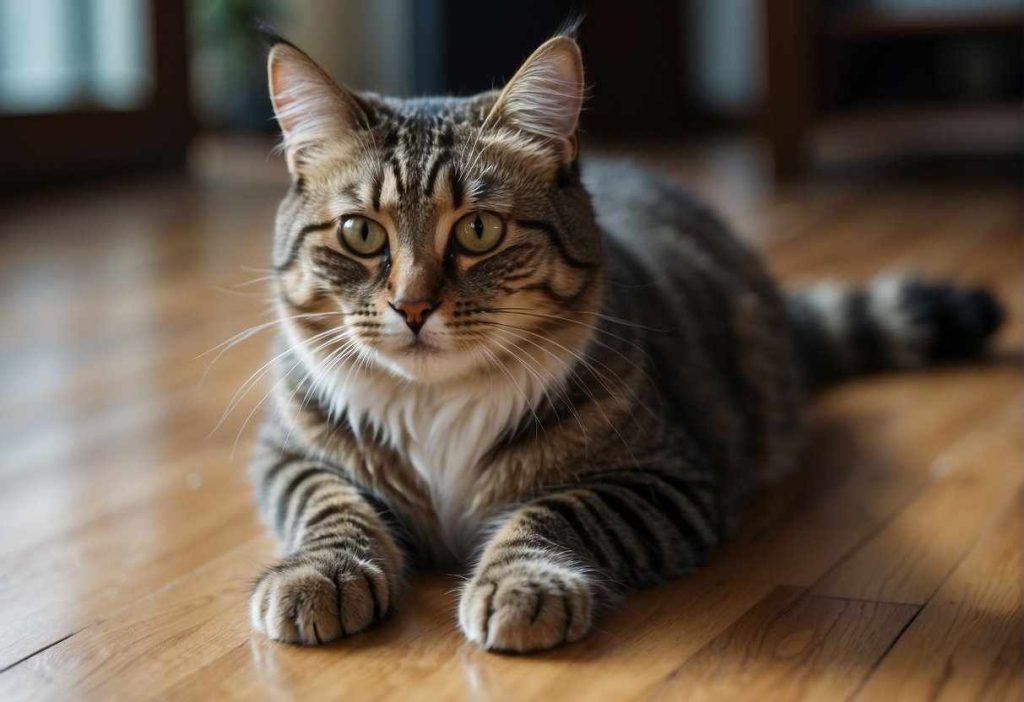
When your furry companion starts rolling around on your floor, it can be a display of various behaviors. Let’s dig into some specifics and unravel this mystery together!
Is rolling on the floor a sign my cat is in pain?
Rolling on the floor isn’t typically a pain signal. Cats often roll to stretch their muscles or to scratch their backs.
However, if accompanied by other signs such as cries or decreased appetite, it might warrant a vet visit.
How can I tell if my cat’s rolling is for attention or due to a health issue?
If your cat is rolling but also seems relaxed, showing their belly, and not avoiding interaction, they’re likely seeking your attention.
Keep an eye out for other symptoms like lethargy or lack of appetite which could indicate a health concern.
Why does my cat roll over when they see me?
When cats greet you with a roll, they’re usually expressing happiness and trust. It’s kind of like them saying, “Hey, I’m glad you’re here! Give me some love!”
Does rolling mean my cat wants its belly rubbed?
Be cautious—cats showing their belly is a sign of trust, not always an invitation for belly rubs.
Many cats prefer not to have their bellies touched. Look for cues like gentle pawing or purring as green lights, but if they seem tense, back off.
Can rolling be a sign of a flea problem or other parasites?
Yes, sometimes. If your cat is rolling more than usual and you notice excessive grooming or scratching, it could be a signal that they’re trying to rid themselves of fleas or other parasites.
How should I interact with my cat when it rolls?
When your cat rolls, respond with gentle strokes, avoiding the belly unless they’re among the few who enjoy it.
Use this as a bonding moment, speaking in soft tones to maintain a soothing environment.
Why does my cat roll around after playing with catnip?
Cats rolling after a catnip session is a common reaction to the herb. It triggers a joyful response.
The rolling is part of their natural play and pleasure behavior. It’s all in good fun!

